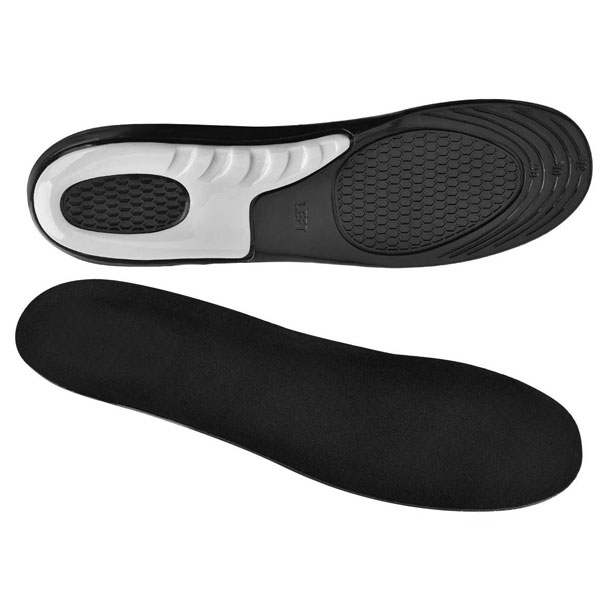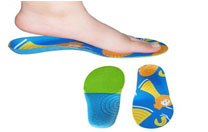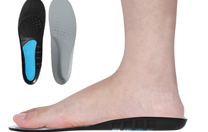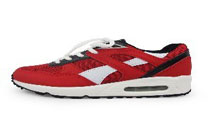The risk of osteoarthritis of the knee joint is high for people who walk in a "splayed" posture, and for those whose shoes' lateral heels are seriously worn-out. In the latest research, a method to prevent knee osteoarthritis and relieve symptoms has been found. The lateral wedge orthopedic insole can change the "splayed" posture.
Knee arthritis is a common chronic disease in the middle-aged and elderly people. With the increase of age, human bones will degenerate and knee joint will be gradually damaged. However, if people's walking posture is not correct, especially if their walking posture is "splayed" and the lateral heels are seriously worn, their medial muscle group of knee joint will be easily strained, which will increase the incidence rate of knee osteoarthritis in medial compartment.
The knee joint is a large and complex joint and consists of three parts: the medial and lateral condyle of the femur and the upper surface of the meniscus, the medial and lateral condyle of the tibia and the lower surface of the meniscus, and the patella on the anterior surface of the patella of the femur. The bony articular surface of the knee joint is covered with a layer of articular cartilage. The articular cartilage makes the rough and uneven articular surface smooth, which can reduce the friction between the articular surfaces. The articular cartilage is elastic and can absorb the impact force during joint activities. At the same time, articular cartilage has different thickness according to different bone surfaces, which can make it more suitable between two bone articular surfaces.
The root cause of knee joint movement diseases is structural and functional changes resulting from various reasons of bone joints and ligaments that maintain joint movement and stable. In terms of chronic injuries, long-term incorrect walking postures, aging and long-term wear can all lead to degeneration of bone joints. The pathological features of degeneration are early degeneration and calcification of cartilage gradually develop into hyperplasia, sclerosis and cystic degeneration of subchondral bone. Finally, joint structure changes, osteophyte formation and joint space stenosis occur, resulting in joint integrity destruction and deformity. In order to avoid or reduce the further damage to the joint surface, all patients with abnormal load-bearing force line in the early and middle stages should have their joint load-bearing force line changed accordingly. However, for those who often wear off the heel and have abnormal walking posture, there must be a problem with the load-bearing line. They should go to a regular hospital as early as possible for plantar pressure testing, and adopt the most scientific correction scheme according to the results of testing and evaluation.
At present, most hospitals detect and obtain data image analysis for patients by means of optical plantar pressure. This detection method is fast, convenient and can clearly judge the pressure distribution of patients' feet. According to professional doctors' analysis of the changes in the weight-bearing line of knee joints caused by this, customized orthopedic insoles meeting the needs of patients' individual feet are edited and designed on the basis of this prescription. At the same time, customized orthopedic insoles are used as early as possible to correct patients with abnormal load-bearing force lines of the knee joint in the early and middle stages, so that joint surface damage caused by abnormal load-bearing force lines can be avoided to the greatest extent. Patients with partial damage of the knee joint can improve or control further development of the disease.
After understanding the causes of knee joint sports diseases, we can carry out targeted prevention:
1. By customizing the orthopedic insole to disperse plantar pressure and correct the body's biological force line, the orthopedic effect can be fundamentally achieved, and at the same time, the abnormal walking posture should be consciously corrected.
2. Try to avoid knee joint injuries, including sprains, etc.
3. Prevent knee joint from cold and keep warm locally.
4. Reduce excessive weight bearing of knee joint, such as lifting heavy objects for a long time.
5. Don't walk on uneven roads for a long time, and don't take part in sports that are harmful to knee joint, such as mountain climbing.
6. Functional training for muscle strength around the knee joint can be properly carried out, such as swimming, knee joint flexion and extension under non-weight bearing conditions and some resistance training. In this way can the stability of the knee joint be enhanced and the possibility
of damage of joint be reduced.
7. Bicycling is a good way to exercise the knee joint under non-heavy load. However, when riding a bicycle, people should adjust the height of the saddle. It is advisable to sit on the saddle and the legs can be straightened or slightly bent on the pedals. A too high or too low saddle or pushing hard when going uphill will have adverse effects on the knee joint, which should be avoided.
8. In terms of diet, people should eat more food that containing protein, calcium, collagen and isoflavone, such as milk and dairy products, beans and bean products, fish and shrimp, kelp, black fungus, chicken feet, pig's hoof, leg of lamb, tendon, etc. These can not only supplement protein and calcium to prevent osteoporosis, but also nourish cartilage and joint moistening fluid. These also supplement estrogen to enable bones and joints to better metabolize calcium, thus relieving symptoms of arthritis.
If discomfort or mild pain is found in the knee joint, you must go to a regular hospital as soon as possible. You should obtain a clear book image diagnosis report through optical plantar pressure detection, and carry out early targeted treatment on the basis of it to avoid further aggravation of knee joint diseases.
Orthopedic insole is currently the best green physical therapy to prevent potential foot diseases. Currently,
orthopedic insoles are generally divided into personalized prescription insoles and function-classified insoles.
The combination of your foot data report ( foot pressure, foot type, foot length and width, etc. ) that is quickly obtained by optical plantar pressure detection with biomechanics evaluation of your lower limbs by professional doctors helps to write a prescription. According to the prescription, designed by professional editing software for customized insoles, after intelligent 3D engraving or 3D printing technology processing plus manual polishing veneer, a customized prescription orthopedic insole that can be fully contacted with is produced.
Customized orthopedic insoles are expensive, but they are more in line with individual needs, and it is recommended that people who can afford them choose customized prescription insoles. In the long run, people especially those with special pathological characteristics (such as diabetic foot, foot pain, knee joint pain, etc.) will benefit greatly from the protection of the foot, the correction of the posture and keeping the human bone and joint aligned.



